Boyer George R. An Economic History of the English Poor Law, 1750-1850
Подождите немного. Документ загружается.

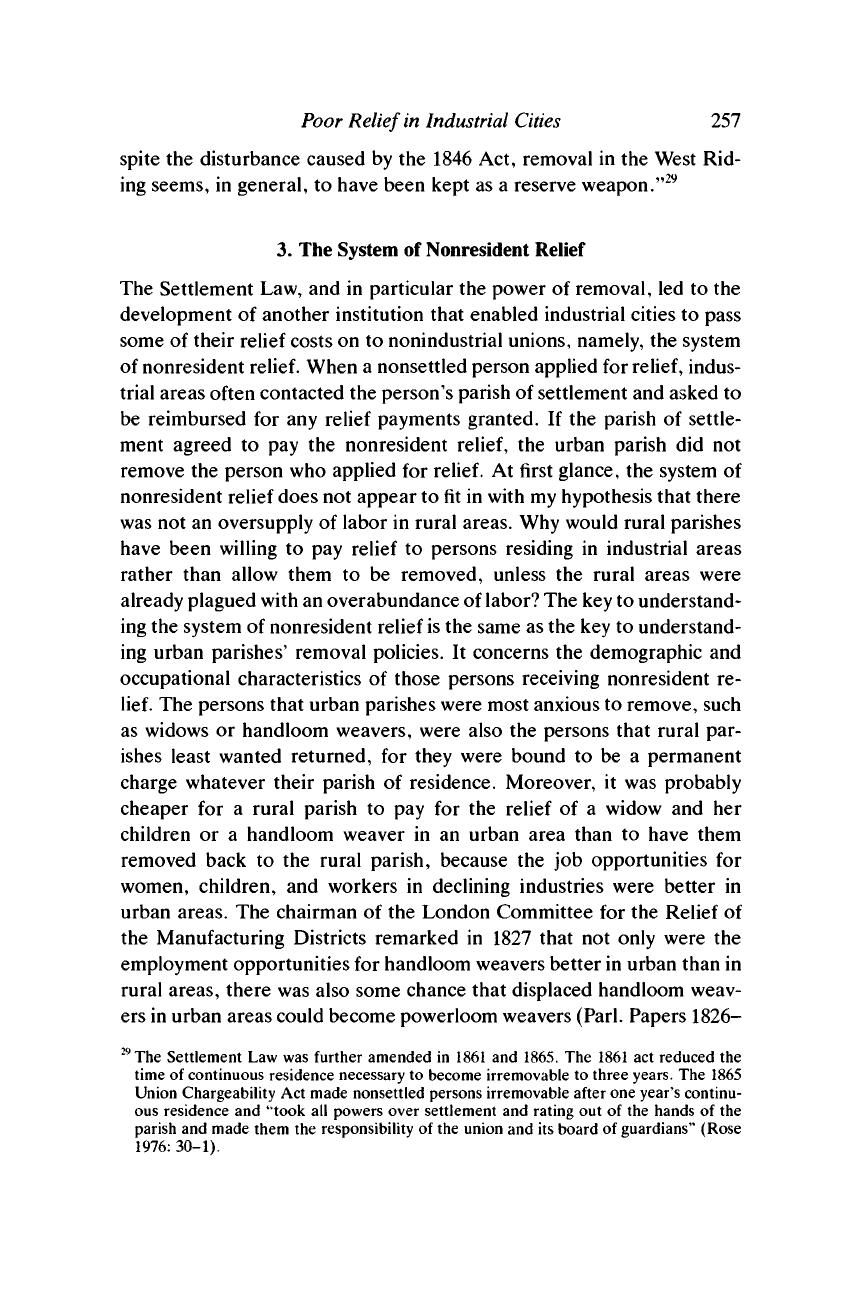
Poor Relief in Industrial
Cities
257
spite
the
disturbance caused
by the
1846
Act,
removal
in the
West
Rid-
ing seems,
in
general,
to
have been kept
as a
reserve weapon."
29
3.
The
System
of
Nonresident Relief
The Settlement
Law, and in
particular
the
power
of
removal,
led to the
development
of
another institution that enabled industrial cities
to
pass
some
of
their relief costs
on to
nonindustrial unions, namely,
the
system
of nonresident
relief.
When
a
nonsettled person applied
for relief,
indus-
trial areas often contacted
the
person's parish
of
settlement
and
asked
to
be reimbursed
for any
relief payments granted.
If the
parish
of
settle-
ment agreed
to pay the
nonresident
relief, the
urban parish
did not
remove
the
person
who
applied
for relief. At
first glance,
the
system
of
nonresident relief does
not
appear
to
fit
in
with my hypothesis that there
was
not an
oversupply
of
labor
in
rural areas.
Why
would rural parishes
have been willing
to pay
relief
to
persons residing
in
industrial areas
rather than allow them
to be
removed, unless
the
rural areas were
already plagued with
an
overabundance
of
labor?
The key
to
understand-
ing
the
system
of
nonresident relief
is
the
same as
the key to
understand-
ing urban parishes' removal policies.
It
concerns
the
demographic
and
occupational characteristics
of
those persons receiving nonresident
re-
lief. The
persons that urban parishes were most anxious
to
remove, such
as widows
or
handloom weavers, were also
the
persons that rural
par-
ishes least wanted returned,
for
they were bound
to be a
permanent
charge whatever their parish
of
residence. Moreover,
it was
probably
cheaper
for a
rural parish
to pay for the
relief
of a
widow
and her
children
or a
handloom weaver
in an
urban area than
to
have them
removed back
to the
rural parish, because
the job
opportunities
for
women, children,
and
workers
in
declining industries were better
in
urban areas.
The
chairman
of the
London Committee
for the
Relief
of
the Manufacturing Districts remarked
in 1827
that
not
only were
the
employment opportunities
for
handloom weavers better
in
urban than
in
rural areas, there
was
also some chance that displaced handloom weav-
ers
in
urban areas could become powerloom weavers (Parl. Papers
1826-
29
The Settlement
Law was
further amended
in
1861
and
1865.
The
1861
act
reduced
the
time
of
continuous residence necessary
to
become irremovable
to
three years.
The 1865
Union Chargeability
Act
made nonsettled persons irremovable after one year's continu-
ous residence
and
"took
all
powers over settlement
and
rating
out of the
hands
of the
parish
and
made them
the
responsibility
of the
union
and its
board
of
guardians" (Rose
1976:
30-1).

258
An
Economic History of the
English Poor
Law
7:
V,
238). Another category
of
persons who often received nonresident
relief
was "old or
infirm people
who had
gone
to
live with younger
or
fitter relatives
in the
industrial towns" (Rose
1965: 281).
Such persons
required less relief
if
they were living
in an
urban area with relatives than
if they were returned
to a
rural parish.
I suspect that
the
share
of
persons receiving nonresident relief
who
were unemployed workers
in
nondeclining industries
was
small. There
were situations, however, where
it
made sense
for
rural parishes
to
grant
nonresident relief
to
able-bodied workers.
If the
urban workers were
only temporarily unemployed,
it
would cost
the
rural parish less
in the
long
run to pay
part
of the
workers' relief
for a
short time than
to
allow
them
to be
returned. This was especially true
if
the workers were
put on
short time rather than laid
off.
Only
if a
rural parish experienced
a
scarcity
of
labor during peak seasons
did it
make sense
to
allow
its
nonresident workers
to be
removed.
The discussion
in the
preceding paragraph assumed that unemployed
nonsettled workers would
be
removed from urban areas
if
they
did not
receive nonresident
relief. I
argued above, however, that industrial
ar-
eas were usually willing
to
relieve nonsettled workers
in
order
to
retain
an adequate supply
of
labor. They often attempted
to
bluff unions into
granting nonresident relief
to
able-bodied workers
by
threatening
to
remove persons that they
in
fact
had no
intention
of
removing (Ashforth
1979:
314).
There
is
evidence that threatened unions were often willing
to call
the
industrial cities' bluffs
by
refusing
to pay for
temporarily
unemployed workers.
For
instance,
the
Leicester Union decided
in 1844
"only
[to]
repay relief administered
to its
non-resident paupers
in
cases
of sickness, infirmity,
or old age"
(Ashforth 1979:
315). In
other words,
Leicester refused
to pay
nonresident relief
to
able-bodied workers.
Wycombe Union agreed to pay nonresident relief only
for
persons "main-
tained
in the
workhouse," which,
of
course, excluded unemployed
or
underemployed workers (Ashforth
1979: 315). In sum, the
parishes
of
settlement agreed
to pay
nonresident relief only
for
those paupers whom
they thought
the
industrial cities would
in
fact remove.
The effect
of the
system
of
nonresident relief
on
urban relief expendi-
tures probably was small because in most cases nonresident relief
was
not
a substitute
for
relief paid
by
industrial parishes. Persons
who
received
nonresident relief typically would have been removed
in its
absence,
rather than relieved. The major savings to industrial
cities,
therefore, was
the cost
of
removing recipients
of
nonresident
relief. If
nonresident relief
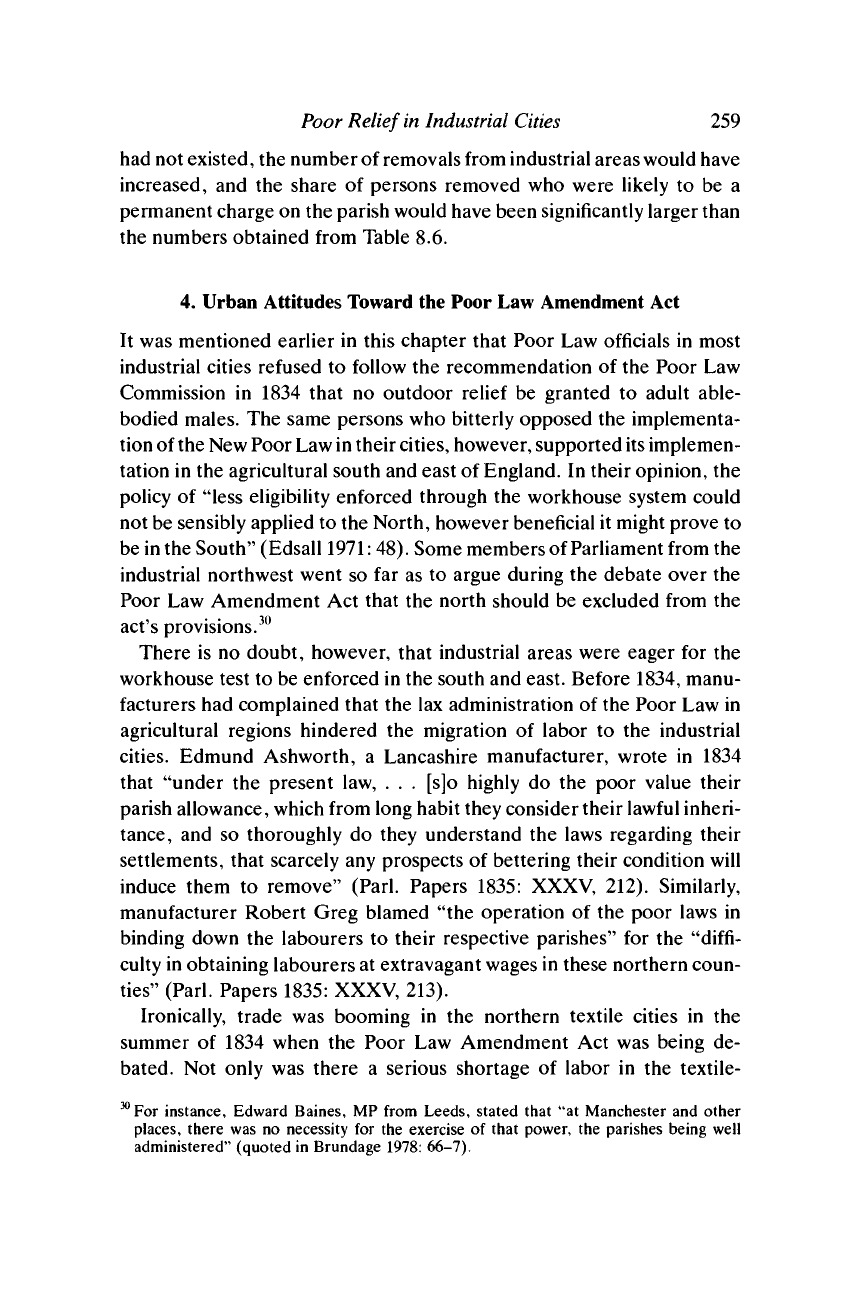
Poor
Relief
in
Industrial
Cities
259
had not existed, the number of removals from industrial areas would have
increased, and the share of persons removed who were likely to be a
permanent charge on the parish would have been significantly larger than
the numbers obtained from Table 8.6.
4.
Urban Attitudes Toward the Poor Law Amendment Act
It was mentioned earlier in this chapter that Poor Law officials in most
industrial cities refused to follow the recommendation of the Poor Law
Commission in 1834 that no outdoor relief be granted to adult able-
bodied males. The same persons who bitterly opposed the implementa-
tion of the New Poor Law
in
their
cities,
however, supported
its
implemen-
tation in the agricultural south and east of England. In their opinion, the
policy of "less eligibility enforced through the workhouse system could
not be sensibly applied to the North, however beneficial it might prove to
be in the South" (Edsall
1971:
48). Some members of Parliament from the
industrial northwest went so far as to argue during the debate over the
Poor Law Amendment Act that the north should be excluded from the
act s provisions.
There is no doubt, however, that industrial areas were eager for the
workhouse test to be enforced in the south and east. Before 1834, manu-
facturers had complained that the lax administration of the Poor Law in
agricultural regions hindered the migration of labor to the industrial
cities.
Edmund Ashworth, a Lancashire manufacturer, wrote in 1834
that "under the present law, . . . [s]o highly do the poor value their
parish allowance, which from long habit they consider their lawful inheri-
tance, and so thoroughly do they understand the laws regarding their
settlements, that scarcely any prospects of bettering their condition will
induce them to remove" (Pad. Papers 1835: XXXV, 212). Similarly,
manufacturer Robert Greg blamed "the operation of the poor laws in
binding down the labourers to their respective parishes" for the "diffi-
culty in obtaining labourers at extravagant wages in these northern coun-
ties"
(Parl. Papers 1835: XXXV, 213).
Ironically, trade was booming in the northern textile cities in the
summer of 1834 when the Poor Law Amendment Act was being de-
bated. Not only was there a serious shortage of labor in the textile-
30
For instance, Edward Baines, MP from Leeds, stated that "at Manchester and other
places, there was no necessity for the exercise of that power, the parishes being well
administered" (quoted in Brundage 1978: 66-7).

260 An Economic History of
the English Poor
Law
producing areas at this time, there was also an "outbreak of trades
unionism," spurred by the strong position of labor (Redford 1964:
113).
31
The labor shortage was exacerbated by the Factory Acts of
1833,
which curtailed the use of child labor in the factories (Redford
1964:
101). Several textile manufacturers, notably Edmund Ashworth
and Robert Greg, responded to the labor scarcity by writing members
of the Royal Poor Law Commission and asking them to encourage the
migration of surplus rural laborers to the industrial north. Ashworth
wrote to Edwin Chadwick that he was "most anxious that every facility
be given to the removal of labourers from one county to another ac-
cording to the demand for labour; this would have a tendency to equal-
ize wages as well as prevent in degree some of the turn-outs [that is,
strikes] which have been of late so prevalent." Greg wrote that "we are
now in want of labour," and that unless labor could be obtained from
the low-wage south, "any farther demand for labour would still further
increase the unions, drunkenness, and high wages" (Parl. Papers 1835:
XXXV, 213).
Assistant Commissioner James Kay, in an 1835 report to the Poor Law
Commissioners, estimated that an additional 45,000 "mill hands" would
be required in the Lancashire cotton district in the next two years.
Because the neighboring counties could supply no more labor, the only
available sources were the rural south and Ireland (Parl. Papers 1835:
XXXV, 186-8). Kay recommended that the commissioners appoint an
agent in Manchester to "form a medium of communication between the
mill-owners, seeking a supply of labour, and the Commissioners, who,
by means of their Assistant Commissioners in the south, may make a
proper selection of the workmen, and transmit them directly to the mills
for which they are required" (Parl. Papers 1835: XXXV, 189).
In response to the manufacturers' suggestions, the Poor Law Commis-
sioners sent a circular letter in March 1835 to manufacturers in districts
where "there existed the greatest demand for labourers," offering "to
those who had a demand for labourers to make the circumstance known
31
Unionism experienced an "exceptional and short-lived [burst] of expansion" from 1829
to 1834 (Hunt
1981:
193). The cotton spinners were particularly successful in organizing
during this period. The expansion culminated in the formation of the Grand National
Consolidated Trades Union in 1833. The GNCTU collapsed in midsummer 1834, but it
claimed to have 800,000 members during its short life (Hunt 1981: 202-3). As can be
seen from the quotes later in the paragraph, manufacturers were hopeful that the unions
could be broken by an influx of labor from the south, although, ironically, the union
movement had collapsed by the time the first migrants were sent to the northwest.
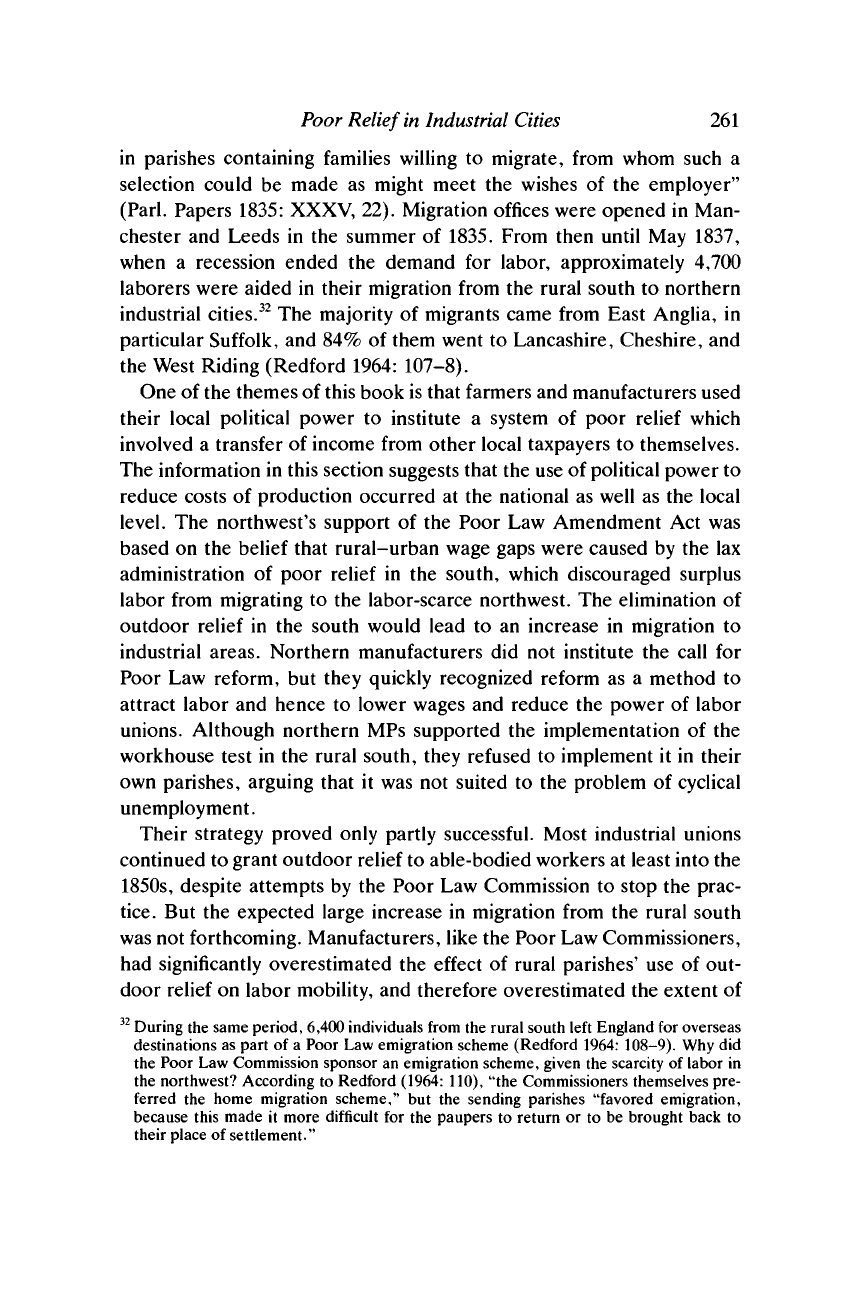
Poor
Relief
in
Industrial
Cities
261
in parishes containing families willing to migrate, from whom such a
selection could be made as might meet the wishes of the employer"
(Pad. Papers 1835: XXXV, 22). Migration offices were opened in Man-
chester and Leeds in the summer of 1835. From then until May 1837,
when a recession ended the demand for labor, approximately 4,700
laborers were aided in their migration from the rural south to northern
industrial cities.
32
The majority of migrants came from East Anglia, in
particular Suffolk, and 84% of them went to Lancashire, Cheshire, and
the West Riding (Redford 1964: 107-8).
One of the themes of this book is that farmers and manufacturers used
their local political power to institute a system of poor relief which
involved a transfer of income from other local taxpayers to themselves.
The information in this section suggests that the use of political power to
reduce costs of production occurred at the national as well as the local
level. The northwest's support of the Poor Law Amendment Act was
based on the belief that rural-urban wage gaps were caused by the lax
administration of poor relief in the south, which discouraged surplus
labor from migrating to the labor-scarce northwest. The elimination of
outdoor relief in the south would lead to an increase in migration to
industrial areas. Northern manufacturers did not institute the call for
Poor Law reform, but they quickly recognized reform as a method to
attract labor and hence to lower wages and reduce the power of labor
unions. Although northern MPs supported the implementation of the
workhouse test in the rural south, they refused to implement it in their
own parishes, arguing that it was not suited to the problem of cyclical
unemployment.
Their strategy proved only partly successful. Most industrial unions
continued to grant outdoor relief to able-bodied workers at least into the
1850s, despite attempts by the Poor Law Commission to stop the prac-
tice.
But the expected large increase in migration from the rural south
was not forthcoming. Manufacturers, like the Poor Law Commissioners,
had significantly overestimated the effect of rural parishes' use of out-
door relief on labor mobility, and therefore overestimated the extent of
32
During the same period, 6,400 individuals from the rural south left England for overseas
destinations as part of a Poor Law emigration scheme (Redford 1964: 108-9). Why did
the Poor Law Commission sponsor an emigration scheme, given the scarcity of labor in
the northwest? According to Redford (1964: 110), "the Commissioners themselves pre-
ferred the home migration scheme," but the sending parishes "favored emigration,
because this made it more difficult for the paupers to return or to be brought back to
their place of settlement."
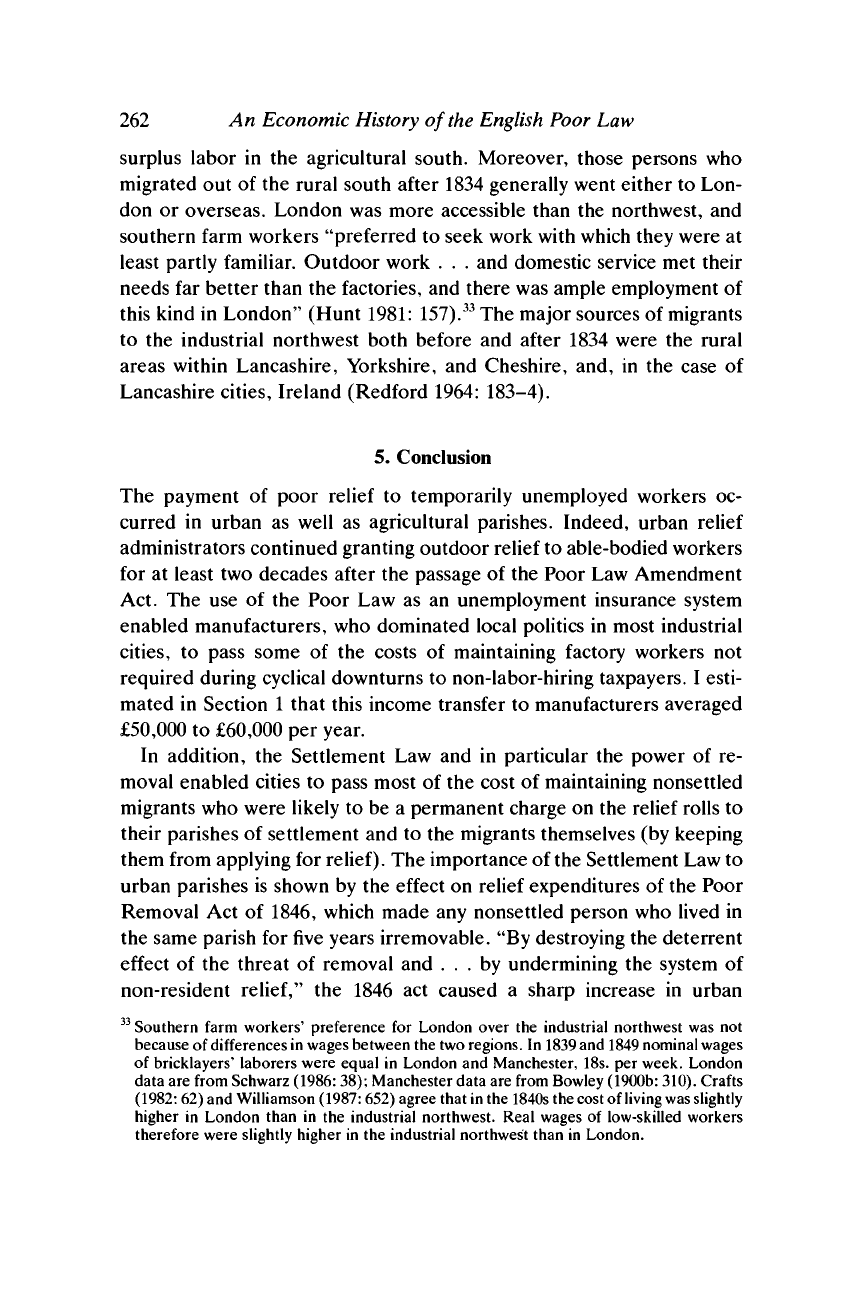
262 An Economic History of the
English Poor
Law
surplus labor in the agricultural south. Moreover, those persons who
migrated out of the rural south after 1834 generally went either to Lon-
don or overseas. London was more accessible than the northwest, and
southern farm workers "preferred to seek work with which they were at
least partly familiar. Outdoor work . . . and domestic service met their
needs far better than the factories, and there was ample employment of
this kind in London" (Hunt
1981:
157).
33
The major sources of migrants
to the industrial northwest both before and after 1834 were the rural
areas within Lancashire, Yorkshire, and Cheshire, and, in the case of
Lancashire cities, Ireland (Redford 1964: 183-4).
5. Conclusion
The payment of poor relief to temporarily unemployed workers oc-
curred in urban as well as agricultural parishes. Indeed, urban relief
administrators continued granting outdoor relief to able-bodied workers
for at least two decades after the passage of the Poor Law Amendment
Act. The use of the Poor Law as an unemployment insurance system
enabled manufacturers, who dominated local politics in most industrial
cities,
to pass some of the costs of maintaining factory workers not
required during cyclical downturns to non-labor-hiring taxpayers. I esti-
mated in Section 1 that this income transfer to manufacturers averaged
£50,000 to £60,000 per year.
In addition, the Settlement Law and in particular the power of re-
moval enabled cities to pass most of the cost of maintaining nonsettled
migrants who were likely to be a permanent charge on the relief rolls to
their parishes of settlement and to the migrants themselves (by keeping
them from applying for relief). The importance of the Settlement Law to
urban parishes is shown by the effect on relief expenditures of the Poor
Removal Act of 1846, which made any nonsettled person who lived in
the same parish for five years irremovable. "By destroying the deterrent
effect of the threat of removal and ... by undermining the system of
non-resident
relief,"
the 1846 act caused a sharp increase in urban
33
Southern farm workers' preference for London over the industrial northwest was not
because of differences in wages between the two
regions.
In
1839
and
1849
nominal wages
of bricklayers' laborers were equal in London and Manchester, 18s. per week. London
data are from Schwarz
(1986:
38); Manchester data are from Bowley
(1900b:
310). Crafts
(1982:
62) and Williamson
(1987:
652) agree that in the
1840s
the cost of
living was
slightly
higher in London than in the industrial northwest. Real wages of low-skilled workers
therefore were slightly higher in the industrial northwest than in London.

Poor Relief
in
Industrial
Cities
263
unions' relief expenditures (Ashforth 1985: 78-9, 81). For the five years
ended Lady Day 1861, irremovable paupers accounted for 62.2% of
relief expenditures in Bradford, 60.8% of expenditures in Manchester,
and 39.6% of expenditures in Sheffield (Ashforth 1985: 81).
The Settlement Law and the power of removal saved urban industrial
unions in Lancashire, Cheshire, and the West Riding perhaps £50,000 to
£80,000 per year. If manufacturers paid 35% of the poor rate, as was
assumed above, then the Settlement Law saved them £17,500 to £28,000
per year. The total income transfer from rural taxpayers, non-labor-
hiring urban taxpayers, and nonsettled urban workers to manufacturers
therefore was on the order of £67,500 to £88,000 per year.
34
Given that
savings rates varied across income classes, the income transfer caused
capital accumulation to increase by perhaps £15,000 to £20,000 per
year.
35
However, the Settlement Law also might have had a negative effect
on industrialization. If migration from the agricultural south to the north-
west was slowed by rural workers' fear of removal, then the Settlement
Law fostered a misallocation of labor and slowed the rate of economic
growth. It was determined in Section 2, however, that the selective use
of the power of removal by textile manufacturing cities should not have
deterred able-bodied young adults from migrating to urban areas. More-
over, urban Poor Law unions often granted relief to temporarily unem-
ployed nonsettled workers, which reduced the risk associated with migra-
tion and therefore should have increased the number of migrants. In
sum, urban poor relief had a positive (but small) impact on the English
economy during the first half of the nineteenth century.
34
This estimate was obtained by adding the estimated annual transfer from non-labor-
hiring urban taxpayers to manufacturers resulting from the use of the Poor Law as an
unemployment insurance system (£50,000-£60,000) and the estimated annual transfer
from rural taxpayers and nonsettled urban workers to manufacturers resulting from the
Settlement Law (£17,500-£28,000).
35
1 assume that the savings rate of manufacturers, farmers, and landlords was 30%, that
the savings rate of non-labor-hiring taxpayers was 5-10%, and that workers did not
save.
Crafts (1985: 124-5) estimated that the savings rate of farmers and landlords was
30%
and that the savings rate out of nonagricultural nonlabor income was "not . . . less
than 23 per cent." I assume that textile manufacturers' savings rate was the same as that
of farmers and landlords. Von Tunzelmann (1985: 215) and Crafts (1985: 124) conclude
that "saving out of
wages
was zero." See also Fishlow
(1961:
36). Feinstein
(1978:
76, 93)
estimated that fixed capital formation averaged £50.5 million per annum in the 1840s,
and that
25%
of total investment (£12.6 million) was devoted to industrial buildings and
machinery. If one-third of industrial investment took place in Lancashire, Cheshire, and
the West Riding, then the Poor Law caused capital formation in manufacturing to
increase by 0.4-0.5%.

264
An Economic History of
the
English
Poor Law
Appendix
Occupations Contained
in
Each Classification
of
Worker
in
Table
8.6
General unskilled laborer
Laborer
Factory worker
Skilled worker
in
declining industry
Handloom weaver Calico printer
Woolcomber Fustian cutter
Female
and
child head
of
household
Widow Seamstress
Charwoman Washerwoman
Housewife Orphan
Single woman with children
Skilled worker
in
textiles (nondeclining)
Fuller
Dyer
Spinner
Bleacher
Block printer
Piecer
Slubber
Stretcher
Worker
in
building trades
Carpenter
Joiner
Brickmaker, bricklayer
Mason
Domestic worker
Servant
Gardener
Worker
in
other occupations
Machinist
Millwright
Fitter
Turner
Typecutter
Watchmaker
Smith
Shoemaker
Baker
Tailor
Confectioner
Reeler
Silk weaver
Sizer
Cloth dresser, flax dresser
Power-loom weaver
Silk winder, cotton winder
Cotton picker
Jobber
in
cotton mill
Tiler
Slater
Painter
Glazier
Porter
Winder, cordwinder
Collier
Fruit dealer
Cutler
Cooper
Warehouseman
Jobber
Ostler
Heckler
Hawker
Bookkeeper
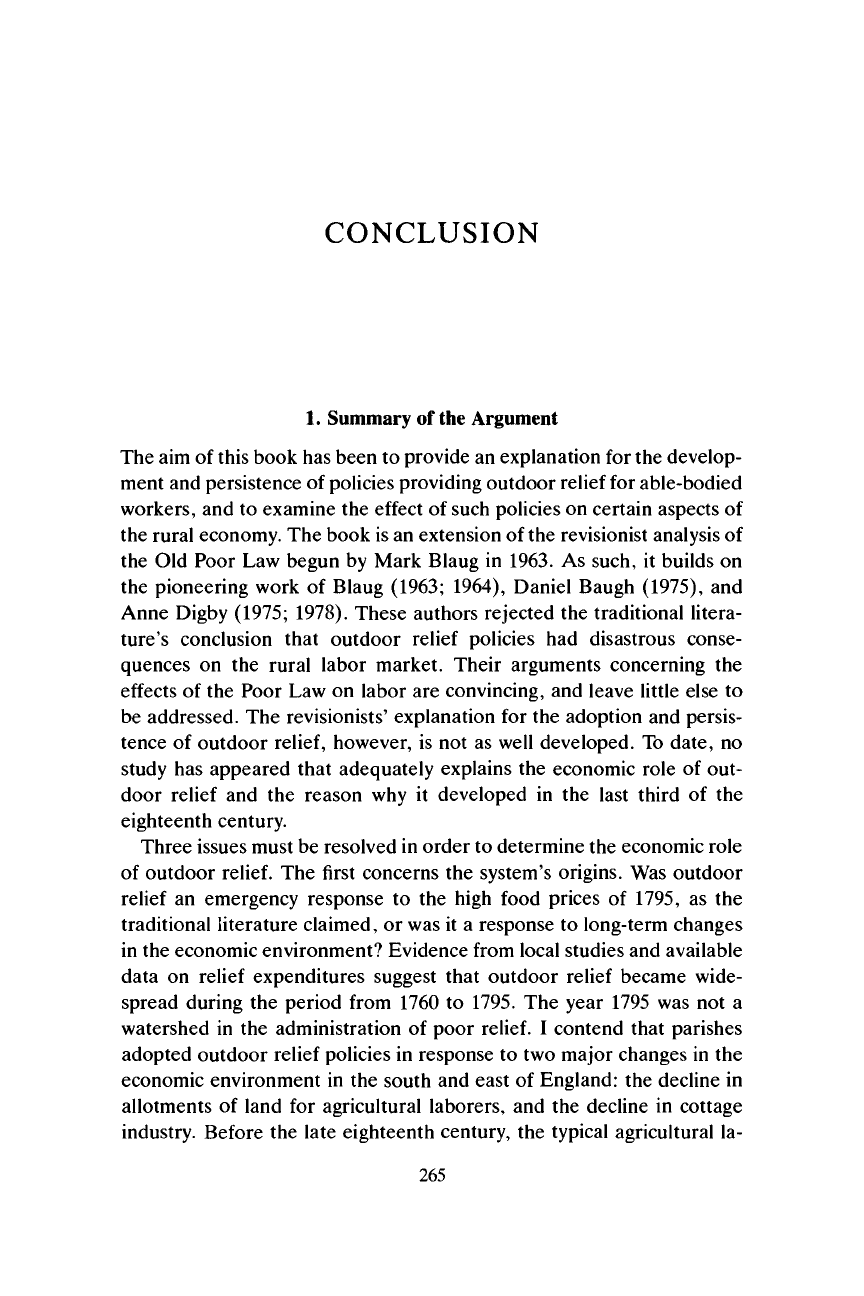
CONCLUSION
1.
Summary
of
the Argument
The
aim of
this book has been
to
provide
an
explanation
for the
develop-
ment
and
persistence
of
policies providing outdoor relief
for
able-bodied
workers,
and to
examine
the
effect
of
such policies
on
certain aspects
of
the rural economy.
The
book
is an
extension
of
the revisionist analysis of
the
Old
Poor
Law
begun
by
Mark Blaug
in
1963.
As
such,
it
builds
on
the pioneering work
of
Blaug
(1963;
1964), Daniel Baugh (1975),
and
Anne Digby (1975; 1978). These authors rejected
the
traditional litera-
ture's conclusion that outdoor relief policies
had
disastrous conse-
quences
on the
rural labor market. Their arguments concerning
the
effects
of the
Poor
Law on
labor
are
convincing,
and
leave little else
to
be addressed.
The
revisionists' explanation
for the
adoption
and
persis-
tence
of
outdoor
relief,
however,
is not as
well developed.
To
date,
no
study
has
appeared that adequately explains
the
economic role
of out-
door relief
and the
reason
why it
developed
in the
last third
of the
eighteenth century.
Three issues must
be
resolved
in
order
to
determine
the
economic role
of outdoor
relief. The
first concerns
the
system's origins.
Was
outdoor
relief
an
emergency response
to the
high food prices
of 1795, as the
traditional literature claimed,
or
was
it a
response
to
long-term changes
in
the
economic environment? Evidence from local studies
and
available
data
on
relief expenditures suggest that outdoor relief became wide-
spread during
the
period from
1760 to 1795. The
year
1795 was not a
watershed
in the
administration
of
poor
relief. I
contend that parishes
adopted outdoor relief policies
in
response
to two
major changes
in the
economic environment
in the
south
and
east
of
England:
the
decline
in
allotments
of
land
for
agricultural laborers,
and the
decline
in
cottage
industry. Before
the
late eighteenth century,
the
typical agricultural
la-
265
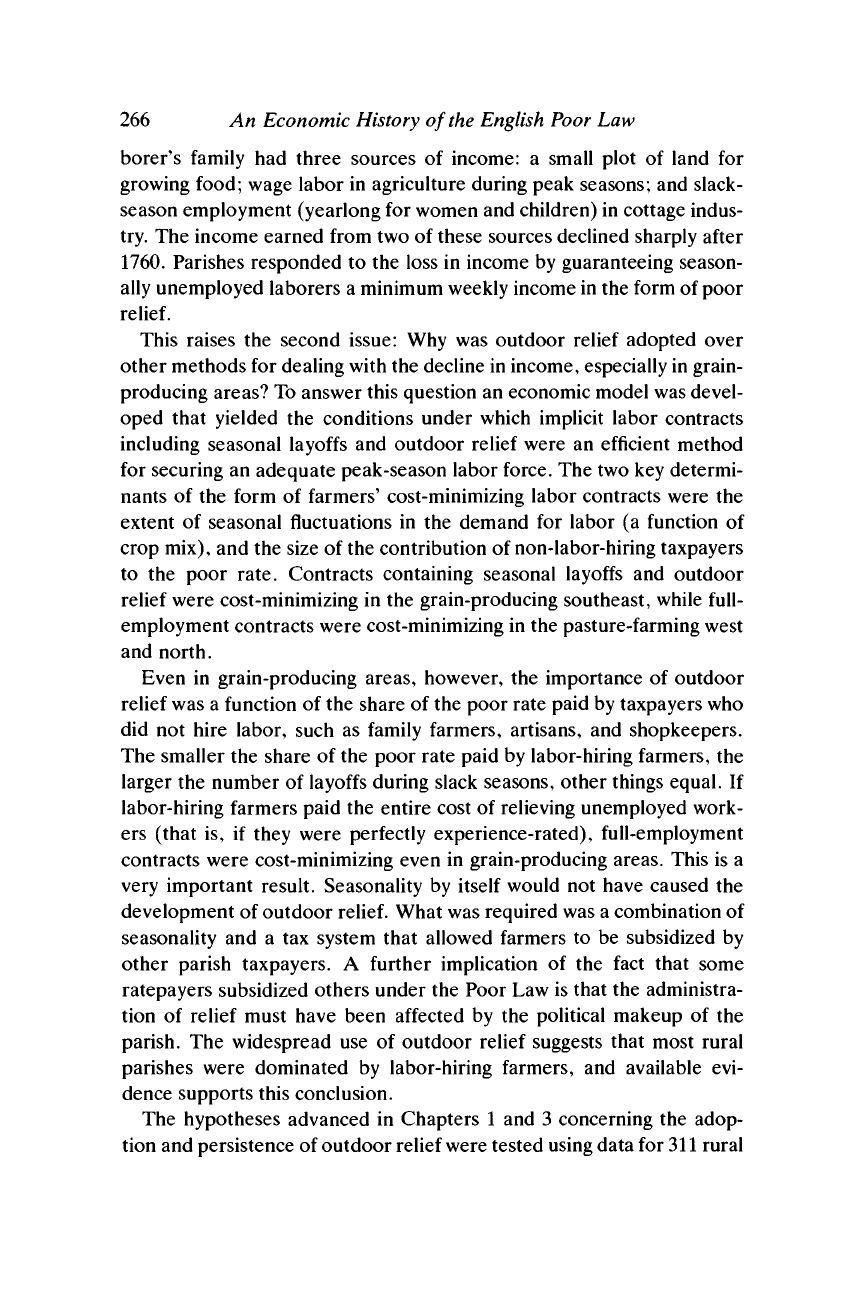
266
An
Economic History of the
English Poor
Law
borer's family
had
three sources
of
income:
a
small plot
of
land
for
growing food; wage labor
in
agriculture during peak seasons;
and
slack-
season employment (yearlong
for
women
and
children)
in
cottage indus-
try.
The
income earned from
two of
these sources declined sharply after
1760.
Parishes responded
to the
loss
in
income
by
guaranteeing season-
ally unemployed laborers
a
minimum weekly income
in the
form
of
poor
relief.
This raises
the
second issue:
Why was
outdoor relief adopted over
other methods
for
dealing with
the
decline
in
income, especially
in
grain-
producing areas? To answer this question
an
economic model was devel-
oped that yielded
the
conditions under which implicit labor contracts
including seasonal layoffs
and
outdoor relief were
an
efficient method
for securing
an
adequate peak-season labor force.
The two key
determi-
nants
of the
form
of
farmers' cost-minimizing labor contracts were
the
extent
of
seasonal fluctuations
in the
demand
for
labor
(a
function
of
crop mix),
and the
size
of
the contribution
of
non-labor-hiring taxpayers
to
the
poor rate. Contracts containing seasonal layoffs
and
outdoor
relief were cost-minimizing
in the
grain-producing southeast, while full-
employment contracts were cost-minimizing
in the
pasture-farming west
and north.
Even
in
grain-producing areas, however,
the
importance
of
outdoor
relief was
a
function
of the
share
of the
poor rate paid
by
taxpayers
who
did
not
hire labor, such
as
family farmers, artisans,
and
shopkeepers.
The smaller
the
share
of the
poor rate paid
by
labor-hiring farmers,
the
larger
the
number
of
layoffs during slack seasons, other things equal.
If
labor-hiring farmers paid
the
entire cost
of
relieving unemployed work-
ers (that
is, if
they were perfectly experience-rated), full-employment
contracts were cost-minimizing even
in
grain-producing areas. This
is a
very important result. Seasonality
by
itself would
not
have caused
the
development
of
outdoor
relief.
What was required was
a
combination of
seasonality
and a tax
system that allowed farmers
to be
subsidized
by
other parish taxpayers.
A
further implication
of the
fact that some
ratepayers subsidized others under
the
Poor
Law is
that
the
administra-
tion
of
relief must have been affected
by the
political makeup
of the
parish.
The
widespread
use of
outdoor relief suggests that most rural
parishes were dominated
by
labor-hiring farmers,
and
available
evi-
dence supports this conclusion.
The hypotheses advanced
in
Chapters
1 and 3
concerning
the
adop-
tion
and
persistence
of
outdoor relief were tested using data
for
311
rural
